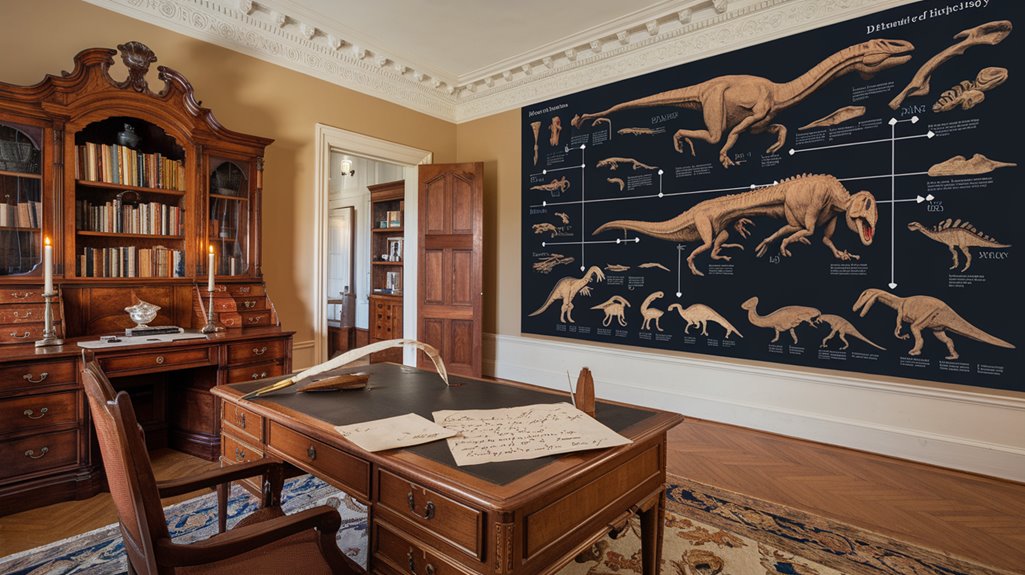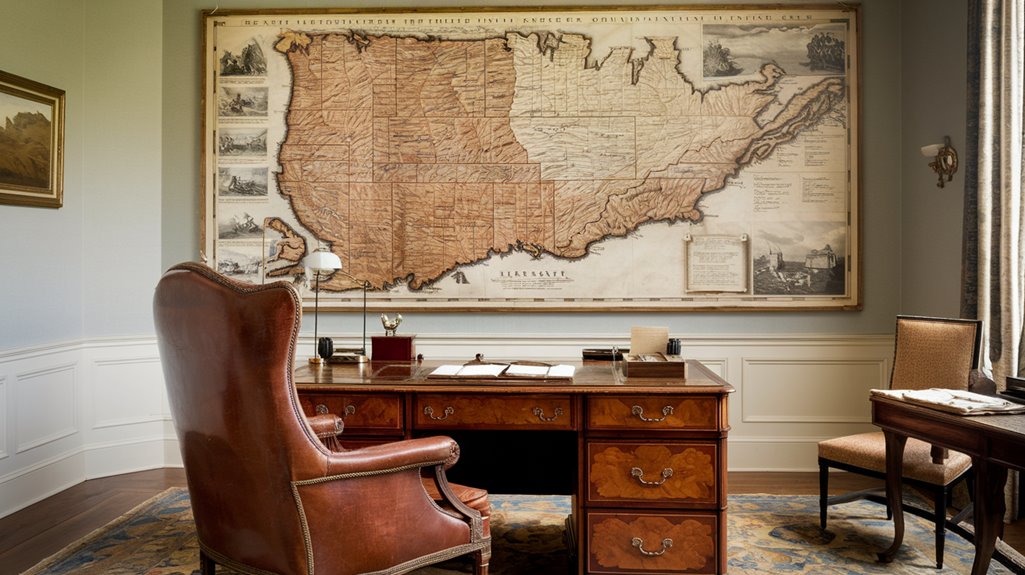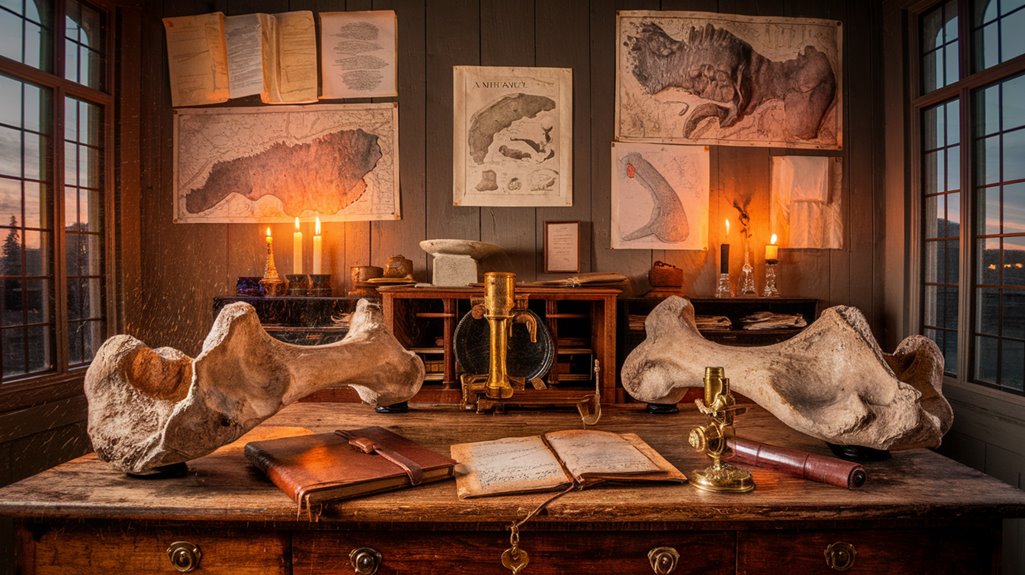George Washington Died Before Dinosaurs Were Discovered
You've heard of George Washington crossing the Delaware, leading the Revolution, and becoming America's first president, but you haven't thought about what he didn't know. When Washington took his final breath in 1799, he'd never learned about the massive creatures that once ruled the Earth. The dinosaurs remained hidden in time, waiting decades after his death to be properly identified. This fascinating gap between two historical milestones offers a unique window into how scientific knowledge has evolved.
The Historical Timeline: Washington's Era vs. Dinosaur Discovery

While George Washington led the American Revolution and served as the nation's first president, the concept of dinosaurs remained entirely unknown to him and his contemporaries.
When Washington died in 1799, you wouldn't have found a single person who understood what dinosaurs were. After developing a severe throat infection, Washington passed away at his Mount Vernon home surrounded by his closest companions. Washington's ignorance of these prehistoric creatures wasn't unusual for his time – even the few fossil bones that had been discovered were misinterpreted as belonging to giant humans.
The first dinosaur bone illustration appeared in 1676, but scientists didn't recognize its true nature. English naturalist Robert Plot believed these mysterious remains belonged to an ancient race of giants. It wasn't until more than two decades after Washington's death that the first scientific dinosaur descriptions emerged with Mantell's Iguanodon discovery in 1822.
These dinosaur misconceptions persisted throughout the 18th century, and the term "dinosaur" wasn't coined until 1842.
Medical Understanding in the 18th Century: Washington's Final Days
Just as dinosaurs remained undiscovered during Washington's lifetime, medical knowledge in the 18th century was equally primitive.
Doctors based their treatments on the humoral theory, believing that illnesses stemmed from imbalances in the body's four humors: black bile, yellow bile, blood, and phlegm. Among their trusted remedies were toxic compounds like mercury and arsenic.
The medical field was dominated by practitioners who received their training through seven-year apprenticeships rather than formal medical schools.
You can see how this limited understanding affected Washington's final days.
When he developed severe respiratory symptoms, his doctors followed the standard medical practices of their time. They bled him four times in just 12 hours, removing about 40% of his blood volume.
They also had him gargle with a mixture of molasses, vinegar, and butter.
Today, experts believe Washington likely suffered from acute bacterial epiglottitis, a condition that modern antibiotics could have easily treated.
Early Fossil Findings and Misinterpretations
Much like the medical misconceptions of Washington's era, early interpretations of fossil findings were based on limited knowledge and flawed assumptions.
When Robert Plot discovered a massive femur in 1677, he thought it belonged to a giant human – a common fossil misinterpretation that persisted through the 18th century.
You'll find it interesting that scientists didn't recognize these remains as ancient reptiles until the 1820s, decades after Washington's death in 1799.
The concept of dinosaurs as they're understood today didn't exist until 1842, when Sir Richard Owen introduced the term.
During Washington's lifetime, people simply couldn't comprehend the existence of these prehistoric creatures.
Even the groundbreaking Iguanodon discovery by Mary Ann Mantell in 1822 came more than two decades after Washington's passing.
William Buckland made history when he introduced the first named dinosaur, Megalosaurus, at the Geological Society of London in 1824.
Joseph Leidy made history when he described the first complete skeleton of a dinosaur in 1856.
The Evolution of Paleontology After Washington
After Washington's death in 1799, paleontology underwent remarkable transformations that revolutionized our understanding of Earth's history.
The early scientific study of fossils emerged from natural philosophers' collections of specimens in the 16th century, setting important precedents.
You'd be amazed by the paleontological milestones that followed, starting with Adolphe Brongniart's groundbreaking work in 1828 that divided plant history into four distinct periods.
Mary Anning and her brother made history in 1811 by discovering the first complete Ichthyosaur skeleton at Lyme Regis.
The field truly took shape when Richard Owen coined the term "Dinosauria" in 1841, while John Phillips established the geological time scale that same year.
Fossil classification advanced considerably through the work of pioneers like Gideon Mantell, who studied the Iguanodon, and Edward Hitchcock, who discovered dinosaur tracks in 1836.
The competitive expeditions of O.C. Marsh and Edward Drinker Cope in the 1870s unearthed numerous new species, setting the stage for modern paleontology's systematic approach to understanding prehistoric life.
The Legacy of Two Unconnected Historical Events

The historical paths of George Washington and dinosaur discoveries never intersected, creating a fascinating contrast in American history. When Washington's death shook the nation in 1799, you'd find no mention of dinosaurs in scientific literature.
While Washington's influence shaped America's foundation through military leadership and presidential precedents, the concept of dinosaurs wouldn't emerge until decades after his passing. Before dying from what experts now believe was acute bacterial epiglottitis, Washington endured several antiquated medical treatments. His decision to step away from power after two terms established a lasting precedent for future presidents.











